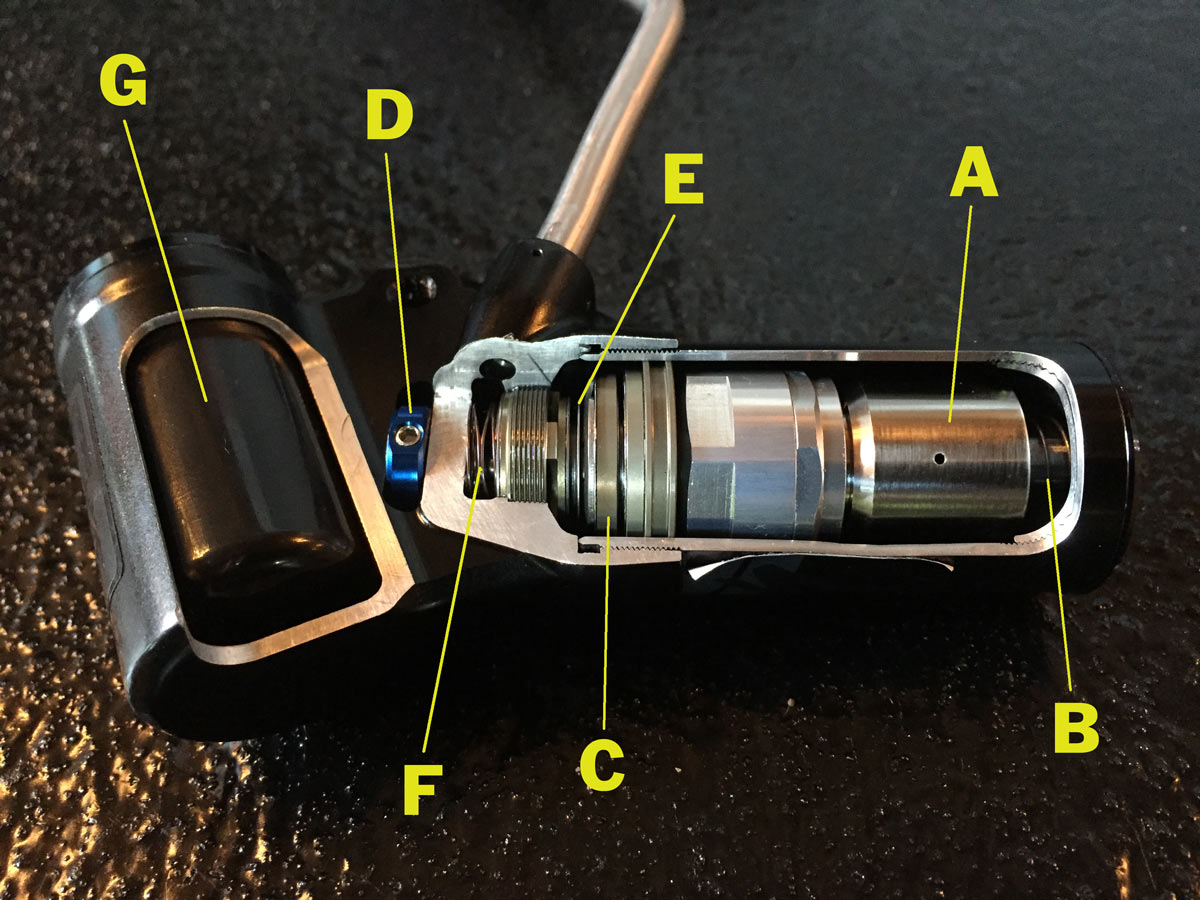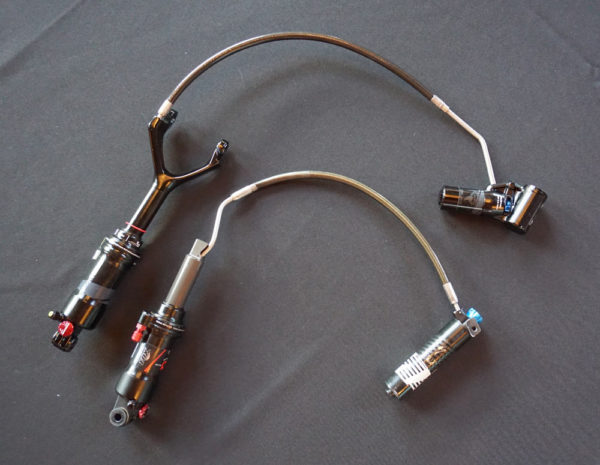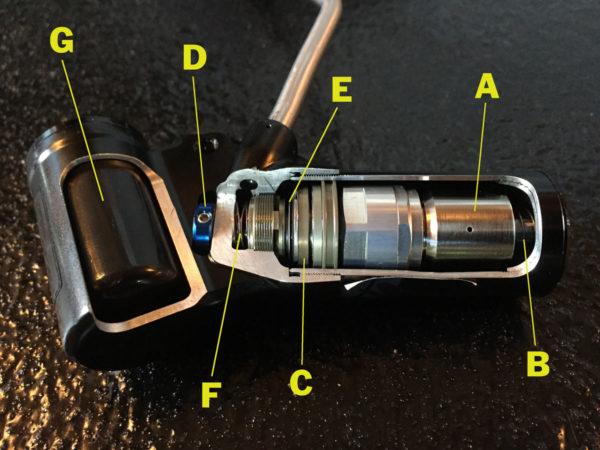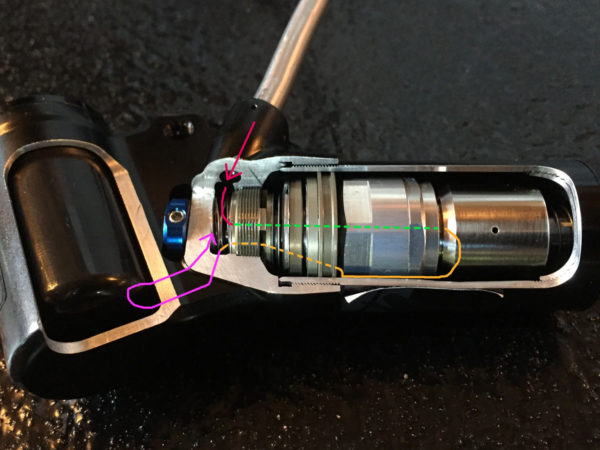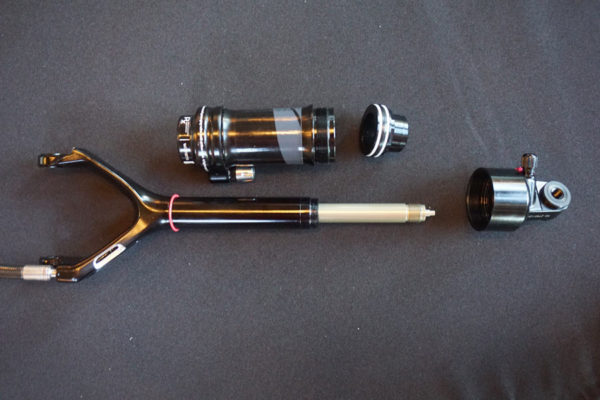To make the all-new 2018 Specialized Epic FSR as efficient and capable as possible, they had to rethink their BRAIN suspension platform. Over the past 15 years, it’s seen a little innovation, but it still relied on a brass mass to hold the ports mostly closed until the rear wheel hit something hard enough to move the axle faster enough such that a spring couldn’t hold the mass against the ports, and it opened flow.
The new version switched it around a little by leaving low speed ports open so the shock is sensitive to small inputs without succumbing to pedal bob. The Horst Link design is, after all, a very active suspension platform that benefits from something like the BRAIN when pedaling efficiency is more important than wide open bump absorption. So, the brass mass inertia system is still there, it just leaves a little gap at the top for small bump oil flow to pass by.
In the image above, the new 2018 BRAIN system is shown on top of last year’s model. Note how the hose connecting the air canister with the BRAIN canister runs directly through the yoke. Another external difference is the reservoir now sits separately atop the damping circuit. Let’s take a look inside…
Here’s what you’re looking at, click to enlarge image:
A: Brass Mass (BM)
B: Biasing spring that holds BM in place
C: Spike Valve
D: BRAIN Fade Knob
E: Emergency blowoff valve
F: One-way check valve to control oil flow direction
G: IFP Bladder
And here’s what all that stuff does: The brass mass (A) wants to stay put (an object at rest tends to stay at rest). In the Firm position, ALL of the oil is running through a damping circuit. As you open it up, oil starts to bypass the BRAIN system more and more, up to the point where you’re barely able to feel any platform. In the prior BRAIN shocks, once you moved it into any open setting, the oil essentially bypassed all of the damping circuits, effectively taking away a lot of the shock’s performance even if you only wanted to “soften the nose” off the platform. Now, you get actual, discernible platform adjustments without giving up normal low- and high-speed compression damping.
The BRAIN knob (D) turns a shaft running through the center of the valve body, which turns a plate with a large kidney shaped hole in it over smaller ports. In Closed (Firm) mode, the plate is completely covering all ports. With each click (four levels of Open), it uncovers one small hole per click.
They’ve also done away with the traditional IFP in favor of a bladder (G). Normally an IFP (Internal Floating Piston) is just that, a piston inside the shock that separates a pressurized nitrogen chamber from the oil. It keeps the oil flowing properly and doesn’t allow any room for air bubbles (aka cavitation) to form since there’s always pressure on the oil. The downside is that the seals on the piston must be tight because the nitrogen chamber can be up to 300psi. A bladder doesn’t suffer from any of that stiction, and it produces less heat because it’s not sliding against the sides of the canister. Specialized puts 180psi of nitrogen gas inside the bladder to maintain pressure on the system to prevent cavitation.
The Spike Valve (C) is a regressive valving that produces a flat compression curve, which means it maintains control and movement deeper into its travel. It works by controlling oil flow more carefully up to a specific flow speed, after which it dumps open to take a big hit. Inside the Spike Valve is the entire low speed compression circuit. There are flow ports leading to a shim stack, which gives them the low speed control they want. Once flow rate is too fast to move through those ports and/or the shims are bending too much and starting to ramp up their resistance (essentially creating hydraulic lock because the fluid is moving too fast for the ports), then the entire low speed circuit simply slides up and out of the way to let more oil flow around it. What that means for the rider is that it’ll stay plush and smooth even through successive big hits instead of jacking up because the spring rate isn’t ramping up too steep at the end of the stroke.
Here’s the oil flow path, dotted lines indicate oil flowing inside/through a circuit (click to enlarge). Oil enters the damping circuit along the red line. The green line shows where oil flows through a central port toward the brass mass. More oil is able to flow past it the more you open up the BRAIN platform using the blue knob. A big hit causes the BM to slide down and let all the oil flow past it, then the spring pushes it back into place to close off the ports. Oil then flows around the center assembly (orange) and into the Spike Valve and low speed circuits, then flows into the reservoir (pink) before returning through the entry port.
Another nice update is the improved serviceability. Because the oil and IFP are contained inside the BRAIN unit, the air canister can be easily removed with common shop tools and cleaned, lubed and inspected, then right back on the bike in about 10 minutes.
The new BRAIN shock retains their Auto-Sag feature, making setup quick and easy, taking all the guesswork out of your initial position. My test rides left it where it ended up and it worked great on a well planned XC course. Stay tuned for our first ride impressions, actual weights and full retail pricing and specs over the next few days.
